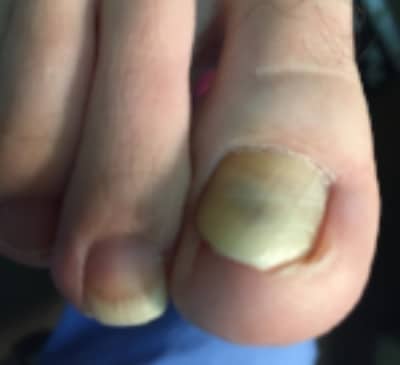
How to Cut an Ingrown Toenail
Step by Step guide to remove an ingrown toenail

Infected ingrown toenail, Beaver Pa
Soften the nail by soaking in warm, not hot water
Clean your nail clippers or scissors with a disinfectant.
Normal nails are cut straight across, but for infected ingrown nail treatment you must trim down the side of the nail where it pierces the skin. This may be very painful.
Do not place a piece of cotton between the ingrown nail and skin. you would have to leave it there for months to change the growth pattern and it adds pressure to the already inflamed area.
Topical antibiotic ointment cream and a band-aid should then be applied until all the redness is gone, which may take a few weeks.
You may remove the band-aid at night while sleeping to air it out. Soaking at night also helps, either in epsom salt water or apple cider vinegar.
Wear shoes that don’t press on the sore area.
when you make a worse mess of it, call a podiatrist
Common Causes of an Ingrown Toenail
The most common causes of an ingrown toenail include:
Genetic predisposition
Tight shoes
Improper cutting off toenails
Bumping or dropping something on the toe
Picking at the toenails
Sports like soccer or running
Seeking Medical Care
It is wise to seek medical attention whenever an ingrown toenail develops into an infection. You should see a doctor even when the ingrown toenail is only inflamed without infection if you answer yes to any of the following questions.
- Has it been more than five years since your last tetanus booster shot?
- Have you tried three days of in home care without any improvement? There is more information on in home care options below.
- Do you have poor circulation, AIDS, diabetes, are you on chemotherapy or do you have another reason for poor wound healing or increased risk of infection?
How To Prevent Ingrown Toenail?
1. Ensure that your feet are well-protected.
The most agonizing moment of our life is stubbed your pinky toe on the table’s corner. It’s not only painful, but it can also cause ingrown nails if your toe is repeatedly struck in this manner. If your toe is repeatedly struck in this manner, it will develop injuries and ingrown nails.
However, stubbed toes aren’t the only issue to avoid; problems such as dumping stuff on your feet should also be avoided.
True, accidents cannot be avoided, but they can be avoided by protecting your feet. Before completing any dangerous work, make sure your feet are fully protected, and never go barefoot anyplace.
These simple tips will keep ingrown nails at bay and protect your feet.
2. Getting Your Nail Trimmed Correctly
Your doctor may have told you that it happened because you didn’t correctly cut your nail the last time you visited for treatment. Ingrown nails are more likely if your nails are curved, as the curve angle makes it simpler for your nail to grow into the skin.
You may not realize it, but clipping your nails incorrectly can lead to problems such as ingrown toenails. But now is the moment to shift your perspective and begin properly pruning them.
What to do if your ingrown nail is infected?
If you have an infected ingrown nail, it’s important to take prompt action to prevent the infection from worsening. Here are steps you can take:
Soak the affected area: Soak your infected ingrown nail in warm water for 15-20 minutes, two to three times a day. This helps reduce pain, swelling, and infection. You can add a mild antiseptic solution like diluted hydrogen peroxide or Epsom salt to the water.
Keep the area clean: Gently clean the infected nail area with mild soap and water. Be careful not to apply excessive pressure or cause further damage to the nail or surrounding skin.
Apply a topical antibiotic: After soaking and cleaning, apply a thin layer of over-the-counter antibiotic ointment or cream to the infected area. This helps prevent the infection from spreading and promotes healing. Follow the instructions provided with the product and consult a pharmacist if needed.
Protect the nail: If the ingrown nail is causing discomfort, consider using a small piece of sterile cotton or dental floss to gently lift the nail away from the skin. This can provide temporary relief and help the nail grow in the right direction. However, be cautious not to force it or cause additional pain.
Seek medical attention: If the infection persists, worsens, or is accompanied by severe pain, redness, swelling, or pus, it is important to seek medical attention. A healthcare professional, such as a podiatrist or a general practitioner, can assess the severity of the infection and provide appropriate treatment, which may include oral antibiotics, drainage of pus, or, in severe cases, surgical intervention.
Avoid self-treatment and trimming: While it may be tempting to try to resolve the issue on your own, it’s best to avoid attempting to trim or cut the ingrown nail yourself, especially if it is infected.
